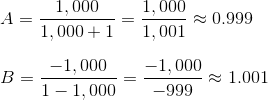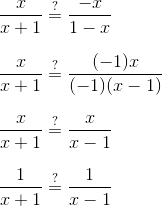This page is part of my unofficial solutions manual to the GRE Paper Practice Book (2e), a free resource available on the ETS website. They publish the questions; I explain the answers. If you haven’t worked through the Practice Book, give Section 6 a shot before reading this!
6.3: Fractions, Two Ways
This problem, with its single, loosely defined variable x, is an excellent illustration of the flexibility we have on Quantitative Comparison questions. We can solve this one either by plugging in a couple times and reasoning about the result, or by simplifying the expression algebraically until one quantity is clearly larger than the other. The two methods take about the same amount of time, and my classroom students are about 50/50 as to which method they find easier.
The Plug-In Approach
We can set x equal to any value greater than 1, but integers will be the easiest to work with. Unless there’s a compelling reason to try improper fractions or decimals, we’ll stick with integer plug-ins in general.
First, let’s try x = 2, the smallest allowable integer value:
In this case, B is greater. At this point we can rule out answer choices (A) and (C), because we now have a counterexample to show that
- At least some of the time, Quantity A is not greater than Quantity B.
- At least some of the time, the two quantities are not equal.
(We only select answer choice (A) if Qty. A is always greater than Qty. B, under all conditions permitted by the problem statement. Likewise, we only select (C) if the quantities are always equal.)
Now let’s try a huge number, just to see if that makes a difference. Let x = 1,000:
Quantity B is still greater. In fact, no matter how high we set x, Qty. B is going to be at least a little bit larger than 1, because its denominator will always be smaller than its numerator. Likewise, Qty. A will always be smaller than 1, because its denominator is always larger than its numerator. Both quantities approach 1 as x increases, but neither actually makes it to the border. The correct answer is (B).
The Algebraic Approach
Now let’s rewind and tackle the problem algebraically. We can think of the comparison as a mathematical relationship — an equation or inequality whose direction, if any, just hasn’t been determined yet:
We can manipulate this mystery relationship the same ways we’d manipulate an equation or inequality, such as
- adding a term to both sides
- subtracting a term from both sides
- multiplying both sides by the same factor
- dividing both sides by the same divisor
The only caveat is that we ought to avoid multiplying or dividing by negative numbers, since those would require us to flip the sign of this “maybe-equation, maybe-inequality.” (It’s not mathematically invalid to do this, but the bookkeeping gets unnecessarily complicated.) Fortunately, x is defined as a positive number, so we won’t need to worry about this for the current problem.
Our goal now is to simplify the two expressions until it’s clear which one, if either, corresponds to the greater quantity.
At this point, it may already be evident that the quantity on the right has to be greater: it has the same numerator as the quantity on the left, but a smaller denominator. If that’s not entirely clear, we can cross-multiply to simplify the expressions even further:
The quantity on the right turns out to be greater regardless of what x we choose, so answer choice (B) is our winner.
Math Review Reference
For more on this topic, see the following sections of the GRE Math Review:
- 1.2: Fractions (pp. 3-4)
- 2.5: Solving Linear Inequalities (pp. 23-24)



